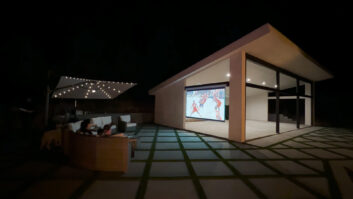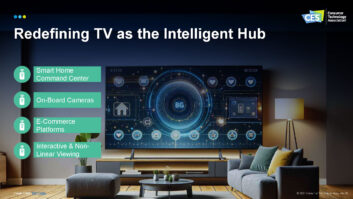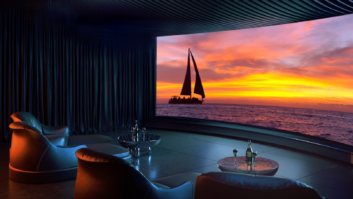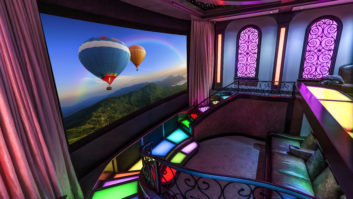Well, folks, Ive just returned from CEDIA EXPO 2006, and as usual, there was no end of classes to teach, friends to meet, and cool new stuff to see. Every show seems to develop its own buzz or unique beat that sets it apart from the others. A few years ago, for example, it was the unfortunate and surprisingly swift demise of the CRT. This year, the unmistakable theme was the evolution of 1080p as the dominant resolution for high-definition video. In addition to 1080p, HD DVD, and Blu-ray Disc offerings, there were native 1920×1080 displays everywhereflat-panel LCDs, plasmas, and video projectors using every technology you can name.
Nowhere was 1080ps preeminence more apparent than at a side show presentation conducted by video wizard Joe Kane of Video Essentials fame. Joe demonstrated clips at 1080i/p using MPEG-2 compression, 720p using Windows Media Video (WMV), and 1080p using VC-1 (the updated, tweaked version of WMV that is receiving universal acclaim on HD DVD). From my seat on the front row, where the viewing angle pushed 50 degrees, the differences were stunning. The 720p WMV content did look better than 1080i and 1080p MPEG-2, but the hands-down winner was 1080p VC-1. Gone were the motion artifacts and compression macro blocking weve come to expect from MPEG-2, leaving nothing but a sharp, detailed, film-like image. The only remaining factor restricting viewing angle was the pixel structure, but it was barely visible from my close vantage point.
The emergence of 1080p into the mainstream raises an interesting issue for home theater design. Traditionally, we have limited the horizontal viewing angle to 30 degrees (screen width = 0.54 x viewing distance) for SD and 36 degrees (screen width = 0.65 x viewing distance) for broadcast HD. With 1080p and improved video codecs like VC-1 and MPEG-4/AVC, we have our first real shot at a true cinematic presentation in the home. Film images are composed to be viewed at an angle of 45 degrees (screen width = 0.83 x viewing distance), which is supported by 35mm film but not HD videoat least not until now. Based on what I saw, 1080p allows us to legitimately increase the viewing angle to 45 degrees without compromising picture quality.
We must, however, avoid the urge to go hog-raving wild with home theater screens that rival Cinerama just because we can. A number of factors ultimately influence what screen and viewing angle are appropriate for a home theater. Perhaps the most important thing to remember is that, for the foreseeable future, only a very small percentage of the program material that our clients will be viewing is 1080p VC-1. The rest will be MPEG-2, mostly at lower resolutions. (MPEG-4 will eventually figure into the mix somewhere.) The 1920×1080 displays havent really been in the field long enough for us to draw hard conclusions, but the early reports are not favorable toward viewing SD and HD MPEG-2 at very wide angles. Its also important to remember that TV images are composed for 27- to 36-inch displays viewed from at least 12 feet away. Thats why the photography features so many tight shots and close-ups. Throw these up on a giant screen and prepare to break out the Dramamine!
As I see it, we have several different ways to reconcile the gap between proper viewing angles for various program material. The first and most appealing to us as custom installers is to have two roomsa dedicated theater with a 45-degree viewing angle for 1080p HD movies that have been pristinely transferred from film, and a multipurpose media room with a 30- to 35-degree viewing angle for standard DVDs, broadcast HD, Blu-ray DVDs with MPEG-2 coding, and for games. Two rooms isnt going to sit well with some clients, so the next best thing is to build a theater where the projector and screen masking can be adjusted from a 45-degree-wide image down to a 30-degree-wide image. Existing projectors dont have the kind of motorized zoom and focus controls required for this operation, so its really only an option for the few experienced clients who are willing to manually reconfigure their projectors. Another solution is to fire two projectors onto the same screen: one small for SD and one big for HD. This could very well be the most popular choice because its the best of both worlds. However, clients may understandably have a difficult time comprehending why they need to buy two projectors instead of one. Ultimately, with the remarkably affordable costs of 720-pixel projectors, a dual-projector approach will be more cost effective than implementing zoom and focus correction systems.
CEDIA made it clear that the future holds bigger, more cinematic HD pictures for home theater. The key for us is to proceed prudently or else run the risk of killing our golden goose. Using 1080p can give us the wide images for movies that weve always craved, but we cant ignore everything else. We know what mistakes to avoid with lower resolutions, so, to paraphrase Dr. Ian Malcolm in Jurassic Park II, lets be careful not to make all new mistakes now that we have 1080p.







